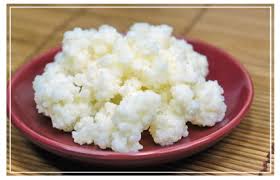Buttermilk
Buttermilk is a by-product of butter manufacture: the aqueous remnant. It is also called traditional butter milk. (Main ingredient for mattentaarten (curd cakes), a local product from Grammont, and a nice way to handle curd.)
Buttermilk has only 0.4g of fat per 100ml. She has about the same protein, vitamins (except A and D) and minerals as whole milk, but less fat and calories.
Buttermilk can also be processed in pancakes, porridge, pudding (custard).
Yogurt and kefir
 Yogurt is a fermented or acidified milk product. It is (more than 4,000 years) prepared by adding the typical milk yogurt bacteria (Lactobacillus bulgaricus and Streptococcus thermophilus). Yogurt digests easily and helps to keep our intestinal flora healthy.
Yogurt is a fermented or acidified milk product. It is (more than 4,000 years) prepared by adding the typical milk yogurt bacteria (Lactobacillus bulgaricus and Streptococcus thermophilus). Yogurt digests easily and helps to keep our intestinal flora healthy.
In Europe, the yogurt actually was only rediscovered in the early 20th century. The first commercial yogurt was brought to market by Isaac Carasso in Barcelona in 1919. His son Daniel or ’Danone’ made it a worldwide famous brand.
To make yogurt, add yogurt to existing (boiled) milk that you keep somewhat comfortable warm. Bacterial strains do the rest.
Kefir (yogurt plant) are white, cauliflower-like pieces, which contain lactose yeast and lactic acid bacterium Lactobacillus caucasicus Beyerinck. It is used to inoculate milk.
Mattentaart (curd cakes)
Milk can keep - certainly without refrigeration - not (long). Therefore people allowed the raw milk to curdle in crud and whey. Curd is the curdled milk that by adding acid (buttermilk) is separated into liquid (whey) and solid (‘matte’ or curd). For 1 kg curd you need about 7 liters of milk and ½ to 1 liter buttermilk. Bring the whole milk to boil. Add the buttermilk.
If there is not enough curd formed, add a spoonful of vinegar to curdle more. Let this boil for about another 15 minutes and then cool. Let the curdeled mass overnight drain through a muslin.
They used curd to make sauces. Afterwards to prepare cakes.
The yellowish acid whey contains little fat, but has vitamins (especially the B group), whey protein, lactose and minerals. It is used in food and (fruity) soft drinks, sauce and soup. The whey that dripped out mostly went to the pigs. The drained curd was ground and mixed with sugar, the egg white and egg yolks. This matt slurry was placed on a square piece of dough that was folded diagonally and baked in an oven. Today is usually used a bottom and lid of puff, and is added some vanilla and almond extract to the ‘matte’.
Supplies for the mats
For about 5 mattentaarten you need fresh : 2.3 liters farm milk, 1.2 liter buttermilk, 4 eggs, 235 grams of sugar (and a few drops of vanilla and almond extract or 80 g ground almonds).
Brush the pastry with egg white to give it a beautiful color and luster. Make in the ‘lid’ a small cross-shaped incision so that the steam can escape during baking and no cavities formed in the stuffing. Put in the oven at 225°C for ½ hour.
‘Yogurt : tastes like it sounds. Just like goulash and squid.’(Henry Beard)
